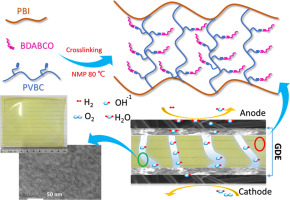当前位置:
X-MOL 学术
›
J. Membr. Sci.
›
论文详情
Our official English website, www.x-mol.net, welcomes your
feedback! (Note: you will need to create a separate account there.)
Functionalization of polybenzimidazole-crosslinked poly(vinylbenzyl chloride) with two cyclic quaternary ammonium cations for anion exchange membranes
Journal of Membrane Science ( IF 8.4 ) Pub Date : 2018-02-01 , DOI: 10.1016/j.memsci.2017.10.062 Jinkai Hao , Yongyi Jiang , Xueqiang Gao , Wangting Lu , Yu Xiao , Zhigang Shao , Baolian Yi
Journal of Membrane Science ( IF 8.4 ) Pub Date : 2018-02-01 , DOI: 10.1016/j.memsci.2017.10.062 Jinkai Hao , Yongyi Jiang , Xueqiang Gao , Wangting Lu , Yu Xiao , Zhigang Shao , Baolian Yi

|
Abstract The anion exchange membranes (AEMs) with both high ionic conductivity and good stability is always the research focus role for the long-term use of AEM fuel cells. A series of the mechanically and chemically stable PVBC/PBI crosslinked membranes, functionalized with N1-butyl substituted BDABCO groups, were designed, prepared and characterized. With the crosslinking by polybenzimidazole (PBI), the membranes showed good flexibility, strength and low swelling ratio (less than 18%). N1-butyl substituted doubly-charged BDABCO was introduced in the AEMs during the crosslinking reaction instead of the traditional dipping method, benefiting from the improvement compatibility between polymers and BDABCO groups. Attributing to the well-developed phase separation between hydrophilic domains and hydrophobic domains, the family of synthesized AEMs exhibited the higher conductivities than that of DABCO based membranes, which was proved by TEM and SAXS. The M-BDABCO-OH-1:3 with high BDABCO content displayed the highest ionic conductivity of 29.3 and 91.4 mS cm−1 at 20 and 80 °C, respectively. The results of alkaline stability showed that the membranes had the superior chemical stability after immersing in a 1 mol L−1 KOH at 60 °C solution for more than 550 h. Furthermore, the peak power density of an H2/O2 single fuel cell using the optimized M-BDABCO-OH-1:3 was up to 340 mW cm−2 at 0.492 V with the EIS consisting of membrane resistance less than 0.1 Ω cm2 which was much smaller than the other AEMs. Overall, the developed membranes demonstrated the superior performance and would be a promising candidate material for AEMFCs.
中文翻译:

用于阴离子交换膜的聚苯并咪唑交联聚(乙烯基苄基氯)与两个环状季铵阳离子的官能化
摘要 兼具高离子电导率和良好稳定性的阴离子交换膜(AEMs)一直是AEM燃料电池长期使用的研究重点。设计、制备和表征了一系列机械和化学稳定的 PVBC/PBI 交联膜,用 N1-丁基取代的 BDABCO 基团进行功能化。通过聚苯并咪唑 (PBI) 交联,膜表现出良好的柔韧性、强度和低溶胀率(小于 18%)。N1-丁基取代的双电荷 BDABCO 在交联反应过程中被引入 AEMs 中,而不是传统的浸渍方法,受益于聚合物与 BDABCO 基团之间相容性的改善。由于亲水域和疏水域之间的相分离非常发达,合成的 AEM 家族表现出比基于 DABCO 的膜更高的电导率,这已被 TEM 和 SAXS 证明。具有高 BDABCO 含量的 M-BDABCO-OH-1:3 在 20°C 和 80°C 下分别显示出最高的离子电导率,分别为 29.3 和 91.4 mS cm-1。碱稳定性结果表明,该膜在 1 mol L−1 KOH 60 °C 溶液中浸泡 550 h 以上后具有优异的化学稳定性。此外,使用优化的 M-BDABCO-OH-1:3 的 H2/O2 单燃料电池的峰值功率密度在 0.492 V 时高达 340 mW cm-2,EIS 由小于 0.1 Ω cm2 的膜电阻组成,比其他 AEM 小得多。总体而言,开发的膜表现出优异的性能,将成为 AEMFC 的有前途的候选材料。
更新日期:2018-02-01
中文翻译:

用于阴离子交换膜的聚苯并咪唑交联聚(乙烯基苄基氯)与两个环状季铵阳离子的官能化
摘要 兼具高离子电导率和良好稳定性的阴离子交换膜(AEMs)一直是AEM燃料电池长期使用的研究重点。设计、制备和表征了一系列机械和化学稳定的 PVBC/PBI 交联膜,用 N1-丁基取代的 BDABCO 基团进行功能化。通过聚苯并咪唑 (PBI) 交联,膜表现出良好的柔韧性、强度和低溶胀率(小于 18%)。N1-丁基取代的双电荷 BDABCO 在交联反应过程中被引入 AEMs 中,而不是传统的浸渍方法,受益于聚合物与 BDABCO 基团之间相容性的改善。由于亲水域和疏水域之间的相分离非常发达,合成的 AEM 家族表现出比基于 DABCO 的膜更高的电导率,这已被 TEM 和 SAXS 证明。具有高 BDABCO 含量的 M-BDABCO-OH-1:3 在 20°C 和 80°C 下分别显示出最高的离子电导率,分别为 29.3 和 91.4 mS cm-1。碱稳定性结果表明,该膜在 1 mol L−1 KOH 60 °C 溶液中浸泡 550 h 以上后具有优异的化学稳定性。此外,使用优化的 M-BDABCO-OH-1:3 的 H2/O2 单燃料电池的峰值功率密度在 0.492 V 时高达 340 mW cm-2,EIS 由小于 0.1 Ω cm2 的膜电阻组成,比其他 AEM 小得多。总体而言,开发的膜表现出优异的性能,将成为 AEMFC 的有前途的候选材料。











































 京公网安备 11010802027423号
京公网安备 11010802027423号